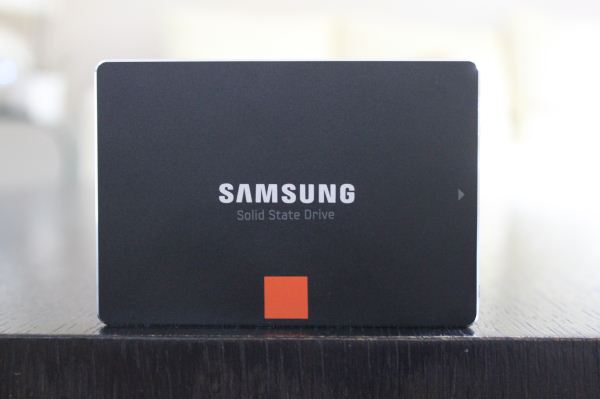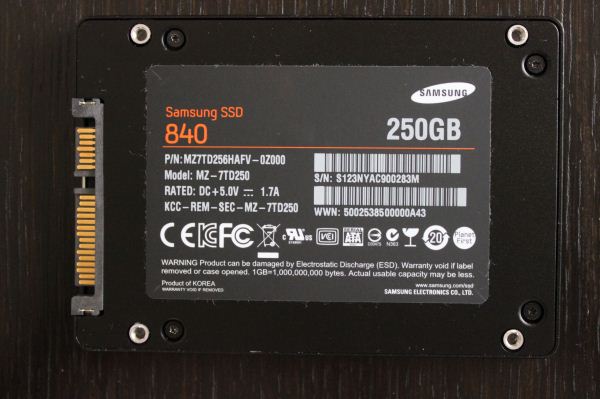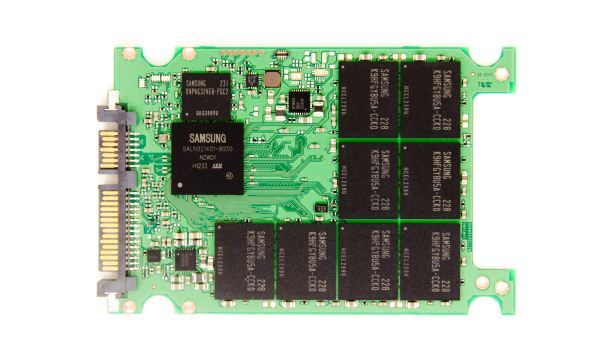Samsung SSD 840 (250GB) Review
by Kristian Vättö on October 8, 2012 12:14 PM EST- Posted in
- Storage
- SSDs
- Samsung
- TLC
- Samsung SSD 840
The Samsung SSD 840
Now it's time to look at the Samsung SSD 840 itself. Performance differences between different capacities are tangible. Sequential write speed in particular increase with larger capacities. With MLC NAND based SSDs 256GB and 512GB models usually perform around the same because 256GB of NAND is able to saturate the limits of the controller but as TLC NAND has longer program times, you will need more NAND dies to hide the additional latency.
| Samsung SSD 840 Specifications | |||
| Capacity | 120GB | 250GB | 500GB |
| Sequential Read | 530MB/s | 540MB/s | 540MB/s |
| Sequential Write | 130MB/s | 250MB/s | 330MB/s |
| 4KB Random Read | 86K IOPS | 96K IOPS | 98K IOPS |
| 4KB Random Write | 32K IOPS | 62K IOPS | 70K IOPS |
| Cache (LPDDR2) | 256MB | 512MB | 512MB |
| Samsung SSD 840 Pro vs 840 vs 830 | ||||
| Samsung SSD 830 (256GB) | Samsung SSD 840 (250GB) | Samsung SSD 840 Pro (256GB) | ||
| Controller | Samsung MCX | Samsung MDX | Samsung MDX | |
| NAND | 27nm Toggle-Mode 1.1 MLC | 21nm Toggle-Mode 2.0 TLC | 21nm Toggle-Mode MLC | |
| Sequential Read | 520MB/s | 540MB/s | 540MB/s | |
| Sequential Write | 400MB/s | 250MB/s | 520MB/s | |
| Random Read | 80K IOPS | 96K IOPS | 100K IOPS | |
| Random Write | 36K IOPS | 62K IOPS | 90K IOPS | |
| Warranty | 3 years | 3 years | 5 years | |
Performance wise the 840 does well but can't challenge the 840 Pro. Read performance is actually nearly on-par with the 840 Pro but write performance is behind due to the use of TLC NAND. I should add that write speeds are still adequate for a consumer drive. In some ways, the 840 can still be a healthy upgrade from the 830. Even though sequential write speed is lower, the increase in random read and write speeds can compensate. Still I suspect most 830 users will want to upgrade to the 840 Pro at least, if they choose not to wait for the next generation of SSDs.
| Samsung SSD 840 Series Pricing | ||||||
| 64GB | 128GB | 256GB | 512GB | |||
| Samsung SSD 840 | N/A | $109.99 (120GB) | $199.99 (250GB) | $449.99 (500GB) | ||
| Samsung SSD 840 Pro | $99.99 | $149.99 | $269.99 | $599.99 | ||
Pricing isn't as aggressive as it could be but keep in mind that the above prices are suggested retail prices. Street prices can easily be ~$20 less and I wouldn't be surprised to see the 120GB SSD 840 retailing for less than $100 (and even $70-80 when on sale). Also note that we're still very early in the production of TLC NAND. Over time you can expect a more appreciable difference in pricing between TLC and MLC NAND.
Based on the chassis alone you can't really tell the difference between the 840 and 840 Pro. Both use a similar matte black plastic design. The 840 measures in at 7mm tall as well, just like the 840 Pro. It's only when you flip the drive around that you can see that it's actually an 840 and not 840 Pro.
Unfortunately, we don't have any pictures of the internals at the moment. Samsung uses special pentalobe screws (similar to MacBook Air) and finding suitable screw drivers in Finland isn't as easy as in the US. In order to get the review out as soon as possible, we decided not to wait for the screwdriver to arrive from the US. We are, however, looking at a PCB that's indentical to the 840 Pro (i.e. eight 32GB TLC NAND packages). The only difference are NAND part numbers.
The 840 Pro
Test System
| CPU |
Intel Core i5-2500K running at 3.3GHz (Turbo and EIST enabled) |
| Motherboard |
AsRock Z68 Pro3 |
| Chipset |
Intel Z68 |
| Chipset Drivers |
Intel 9.1.1.1015 + Intel RST 10.2 |
| Memory | G.Skill RipjawsX DDR3-1600 2 x 4GB (9-9-9-24) |
| Video Card |
XFX AMD Radeon HD 6850 XXX (800MHz core clock; 4.2GHz GDDR5 effective) |
| Video Drivers | AMD Catalyst 10.1 |
| Desktop Resolution | 1920 x 1080 |
| OS | Windows 7 x64 |













86 Comments
View All Comments
xdrol - Monday, October 8, 2012 - link
You sir need to learn how SSDs work. Static data is not static on the flash chip - the controller shuffles it around, exactly because of wear levelling.name99 - Tuesday, October 9, 2012 - link
"I think Kristian should have made this all more clear because too many people don't bother to actually read stuff and just look at charts."Kristian is not the problem.
There is a bizarre fraction of the world of tech "enthusiasts" who are convinced that every change in the world is a conspiracy to screw them over.
These people have been obsessing about the supposed fragility of flash memory from day one. We have YEARS of real world experience with these devices but it means nothing to them. We haven't been screwed yet, but with TLC it's coming, I tell you.
The same people spent years insisting that non-replacable batteries were a disaster waiting to happen.
Fifteen years ago they were whining about the iMac not including a floppy drive, for the past few years they have been whining about recent computers not including an optical drive.
A few weeks ago we saw the exact same thing regarding Apple's new Lightning connector.
The thing you have to remember about these people is
- evidence means NOTHING. you can tell them all the figures you want, about .1% failure rates, or minuscule return rates or whatever. None of that counts against their gut feeling that this won't work, or even better an anecdote that some guy some somewhere had a problem.
- they have NO sense of history. Even if they lived through these transitions before, they cannot see how changes in 2000 are relevant to changes in 2012.
- they will NEVER admit that they were wrong. The best you can possibly get out of them is a grudging acceptance that, yeah, Apple was right to get rid of floppy disks, but they did it too soon.
In other words these are fools that are best ignored. They have zero knowledge of history, zero knowledge of the market, zero knowledge of the technology --- and the grandiose opinions that come from not actually knowing any pesky details or facts.
piiman - Tuesday, February 19, 2013 - link
Then stick with Intel not because they last longer but they have a great warranty.(5 years) My drive went bad at about 3.5 years and Intel replaced it no questions asked and did it very quickly. I sent it in and had a new one 2 days after they received my old one. great service!GTRagnarok - Monday, October 8, 2012 - link
This is assuming a very exaggerated amplification of 10x.Kristian Vättö - Monday, October 8, 2012 - link
Keep in mind that it's an estimation based on the example numbers. 10x write amplification is fairly high for consumer workloads, most usually have something between 1-3x (though it gets a big bigger when taking wear leveling efficiency into account). Either way, we played safe and used 10x.Furthermore, the reported P/E cycle counts are the minimums. You have to be conservative when doing endurance ratings because every single die you sell must be able to achieve that. Hence it's completely possible (and even likely) that TLC can do more than 1,000 P/E cycles. It may be 1,500 or 3,000, I don't know; but 1,000 is the minimum. There is a Samsung 830 at XtremeSystems (had to remove the link as our system thought it was spam, LOL) that has lasted for more than 3,000TiBs, which would translate to over 10,000 P/E cycles (supposedly, that NAND is rated at 3,000 cycles).
Of course, as mentioned at the end of the review, the 840 is something you would recommend to a light user (think about your parents or grandparents for instance), whereas the 840 Pro is the drive for heavier users. Those users are not writing a lot (heck, they may not use their system for days!), hence the endurance is not an issue.
A5 - Monday, October 8, 2012 - link
Ah. I didn't know the 10x WA number was exceedingly conservative. Nevermind, then.TheinsanegamerN - Friday, July 5, 2013 - link
3.5 years is considering you are writing 36.5 GB of data a day. if the computer it is sitting in is mostly used for online work of document editing, youll get far more. the laptop would probably die long before the ssd did.also, this only apples to the tls ssds. mlc ssds last 3 times longer, so the 840 pro would be better for a computer kept longer than 3 years.
Vepsa - Monday, October 8, 2012 - link
Might just be able to convince the wife that this is the way to go for her computer and my computer.CaedenV - Monday, October 8, 2012 - link
That is how I did it. My wife's old 80GB system drive died a bit over a year ago, and it was one of those issues of $75 for a decent HDD, or $100 for an SSD that would be 'big enough' for her as a system drive (60GB at the time). So I spent the extra $25, and it made her ~5 year old Core2Duo machine faster (for day-to-day workloads) than my brand new i7 monster that I had just build (but was still using traditional HDD at the time).I eventually got so frustrated by the performance difference that I ended up finally getting one for myself, and then after my birthday came then I spent my fun money on a 2nd one for RAID0. It did not make a huge performance increase (I mean it was faster in benchmarks, but doubling the speed of instant is still instant lol), but it did allow me to have enough space to load all my programs on the SSD instead of being divided between the SSD and HDD.
AndersLund - Sunday, November 25, 2012 - link
Notice, that setting up a RAID with your SSD might hinder the OS to see the SSDs as SSD and not sending TRIM commands to the disks. My first (and current) gamer system consists of two Intel 80 GB SSD in a RAID0 setup, but the OS (and Intel's toolbox) does not recognize them as SSD.